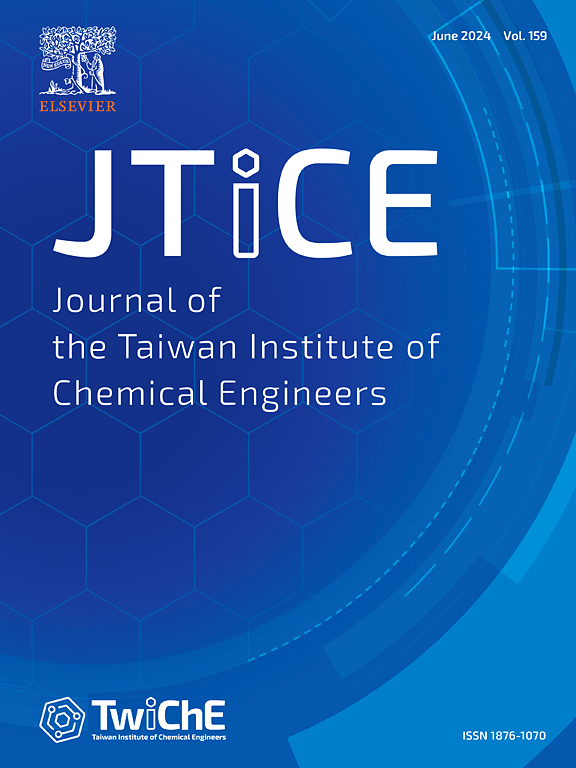双z型异质结构Vo-Bi2WO6/Bi2S3/Ag2S@Chitosan协同降解品红碱性染料
IF 6.3
3区 工程技术
Q1 ENGINEERING, CHEMICAL
Journal of the Taiwan Institute of Chemical Engineers
Pub Date : 2025-07-09
DOI:10.1016/j.jtice.2025.106265
引用次数: 0
摘要
目前的工作是研究紫红在可见光辅助下的基本光降解作为水污染的潜在解决方案。主要目标是通过氧空位生成(OVs)和与Ag2S和Bi2S3形成双Z-scheme异质结来改变Bi2WO6的光电特性。方法氧空位诱导的Bi2WO6/Ag2S/Bi2S3壳聚糖负载异质结体系提供了定向电荷转移通道,在80 min内降解效率达到99.80%。采用水热、共沉淀法和超声分散相结合的方法制备双z型异质结。Vo-Bi2WO6/Ag2S/Bi2S3@chitosan体系在0.0552 min-1速率常数下对FB的降解符合准一级动力学,相对于裸体系要高一些。Vo-Bi2WO6/Ag2S/Bi2S3@Chitosan体系对FB的降解率为99.80%,而Vo-Bi2WO6/Ag2S/Bi2S3、Vo-Bi2WO6/Ag2S、Vo-Bi2WO6、Bi2WO6、Bi2WO6、Ag2S、Bi2S3体系在80 min内对FB的降解率分别为96.08%、64.69%、39.64%、32.64%、23.49%、28.14%。利用密度功能理论(DFT)对裸光催化剂的能带分析和结构构型进行了分析,结果与实验结果吻合较好。同时,采用LC-MS分析对降解产物进行了表征,同时,淬火实验和EPR结果阐明了双Z-scheme电荷转移机理。本研究提出了设计氧空位介导的双Z-scheme体系的合理性,这可能对缓解水污染问题产生影响。本文章由计算机程序翻译,如有差异,请以英文原文为准。

Synergy between dual Z-scheme heterostructured Vo-Bi2WO6/Bi2S3/Ag2S@Chitosan for the effective degradation of fuchsin basic dye
Background
The current work investigates fuchsin basic photodegradation with visible light assistance as a potential solution for water contamination. The main goal is to modify the optoelectronic characteristic properties of Bi2WO6 through oxygen vacancy generation (OVs) and forming dual Z-scheme heterojunction with Ag2S and Bi2S3.
Methods
The oxygen vacancy induced Bi2WO6/Ag2S/Bi2S3 chitosan supported heterojunction system provided directional charge transfer channels with remarkable degradation efficacy of 99.80 % within 80 min. The dual Z-scheme heterojunction was fabricated using combined hydrothermal, co-precipitation and ultrasonic dispersion method. The Vo-Bi2WO6/Ag2S/Bi2S3@chitosan system followed pseudo-first-order kinetics for FB degradation at 0.0552 min-1 rate constant which is comparatively higher to bare counterparts.
Significant findings
The Vo-Bi2WO6/Ag2S/Bi2S3@Chitosan system possessed 99.80 % degradation for FB, whereas the Vo-Bi2WO6/Ag2S/Bi2S3, Vo-Bi2WO6/Ag2S, Vo-Bi2WO6, Bi2WO6, Ag2S, Bi2S3 possessed (96.08 %), (64.69 %), (39.64 %), (32.64 %), (23.49 %), (28.14 %), degradation rate for FB in 80 min. The density functional theory (DFT) investigations provided information on the energy bandgap analysis and structural configuration of the bare photocatalysts, which aligns well with the experimental results. Also, LC-MS analysis was employed to scrutinize the degraded products whilst, quenching experiment, and EPR results explicated the dual Z-scheme charge transfer mechanism. This work advances the rationally of designing oxygen vacancy-mediated dual Z-scheme system, which may have consequences for mitigating water pollution issues.
求助全文
通过发布文献求助,成功后即可免费获取论文全文。
去求助
来源期刊
CiteScore
9.10
自引率
14.00%
发文量
362
审稿时长
35 days
期刊介绍:
Journal of the Taiwan Institute of Chemical Engineers (formerly known as Journal of the Chinese Institute of Chemical Engineers) publishes original works, from fundamental principles to practical applications, in the broad field of chemical engineering with special focus on three aspects: Chemical and Biomolecular Science and Technology, Energy and Environmental Science and Technology, and Materials Science and Technology. Authors should choose for their manuscript an appropriate aspect section and a few related classifications when submitting to the journal online.

 求助内容:
求助内容: 应助结果提醒方式:
应助结果提醒方式:


